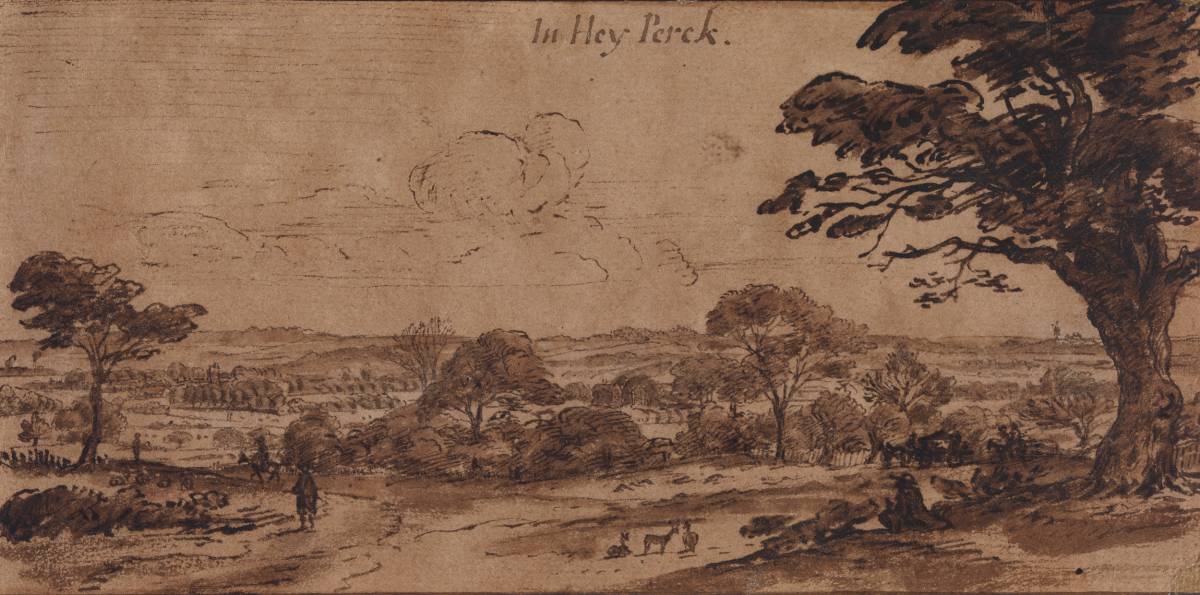This exceptionally early drawing of Hyde Park was made shortly after the Restoration of the monarchy in 1660. It belongs to an important group of views of Britain made by the Dutch traveller and painter Michel van Overbeek. Other drawings from the group document his journey from Dover to London and in the environs the city. This lively sheet depicts a view of Hyde Park offering a rare glimpse of the Royal park shortly before the campaign of formal planting that would transform it from a Tudor hunting ground into a public pleasure garden.
Michel van Overbeek was a Dutch painter and picture dealer, the nephew of the topographical draughtsman Bonaventure van Overbeek. Overbeek senior was born and died in Amsterdam, but was most celebrated for his publication of Roman ruins, Les restes de l'ancienne Rome, which was completed in 1709. Dedicated to Queen Anne the book was, according to Arnold Houbraken, published posthumously by Michel van Overbeek.[1] Like his uncle, Michel seems to have travelled extensively in France and Italy and made what appears to be a brief stay in England from about 1663 until 1666. Both Christopher White and Celina Fox have concluded that he was in London by 1663 as a distant view from Greenwich (Royal collection, Windsor Castle) shows the tower of Old St Paul’s covered with scaffolding which was in place from August 1663 until the church was destroyed by fire on 4 September 1666.
The work from Overbeek’s English tour accords with the contemporary convention of topographical travel views, such as those prepared by the Bohemian etcher, Wenceslaus Hollar in the 1640s.[2] The oblong, ink drawings are all the same size and probably come from a single sketchbook, they are all prominently titled, suggesting Overbeek had some kind of publication in mind. It would seem, from the internal evidence of the extant British drawings that he landed at Dover, probably from France, and travelled up to London. Amongst the five English views by Overbeek in The Fitzwilliam Museum, Cambridge, is a drawing of Dover Castle as well as a view on the Medway. Once in London, he completed several conventional views of the city and its environs, including a fine drawing of the Palace of Westminster from the Thames now in the British Museum, a prospect entitled ‘About Grinwiche’ (Fitzwilliam Museum) and two further views of Westminster (Westminster Public Library). Overbeek seems to have traveled to St Albans, a view of which survives in the British Library, as well as a view of Kingston showing the Copper-mills at Kingston (Yale Center for British Art, New Haven). The largest concentration of studies seem to have been of London’s parks.
Overbeek’s focus on the parks to the west of London perhaps reflects the reorientation in the life of the nation following the Commonwealth, away from Parliament and the City, back to the King, aristocracy and court, who were based at St James’s Palace. Recreation became a conspicuous element of metropolitan life, and London’s parks were used not only for relaxation but, as documents such as the diary of Samuel Pepys reveal, forums for political lobbying and intrigue.
Hyde Park had been acquired by Henry VIII in 1536 from the monks of Westminster Abbey; in Overbeek’s views, the inclusion of herds of deer suggest its initial use as a hunting ground. At the Restoration, it reverted to the Crown and rapidly became a fashionable public space on the western limit of London. In March 1668 Pepys noted: ‘to Hyde Park, the first time we were there this year, or ever in our own coach, where with mighty pride rode up and down, and many coaches there.’[3] In one of the drawings, which shows an extensive landscape looking north from the park, a coach can be seen followed by several fashionably dressed riders.
References
- See K. Jonckheere, The Auction of King William’s Paintings 1713: Elite International Art Trade at the End of the Dutch Golden Age, Amsterdam, 2008, p.54-5.
- For Hollar’s illustrations to Thomas Howard, Earl of Arundel’s tour of 1636, see A. Griffiths and G.Kesnerová, Wenceslaus Hollar Prints and Drawings, exh. cat., London (British Museum), 1983, p.21.
- Samuel Pepys, 18 March, 1669. ed. R. Latham, The Shorter Pepys, Berkeley, 1985, p.999.


